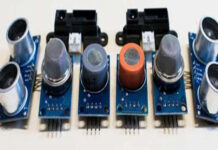Organic electronics offer several more benefits as compared to electronic products based on inorganic materials such as silicon and gallium arsenide. For example, organic semiconductors along with being lightweight and cost-effective, provide mechanical flexibility and the possibility of chemical modifications. In addition, organic electronic materials consume less power. Additionally, a significant property of organic materials-based devices is that these can be produced at room temperature, which allows for the integration of large-area electronic functions cost-effectively on flexible substrates.
Organic electronics is garnering significant traction in the medical industry, particularly in the treatment of blindness by insertion of a retinal chip in a patient’s eye. Organic retinal chips convert light rays entering the eye into electrical signals and transfer them to the brain via the receptor cells. This technology has enabled patients with blindness to distinguish light and dark, object contours, and occasionally even facial expressions and alphabets.
Growing emphasis on technologies for renewable energy generation has fueled demand for organic electronic batteries owing to high-power density of electrodes, and fast charging and discharging benefits.
What Is Driving the Interest in Organic Electronics?
The global organic electronics market size is expected to reach USD 178.25 Billion at a steady CAGR of 15.4% in 2028, according to latest analysis by Emergen Research. Steady market revenue growth can be attributed to rising demand for consumer electronic products and increasing focus on integrating advanced functionalities at reduced cost.
Why is there so much excitement surrounding organic electronics?
There are so many different chemical molecules and functional groups (clusters of atoms with their own distinctive properties). By including functional groups, it becomes relatively simple to tune their electronic characteristics. We can carefully tailor the qualities by combining functional groups that are electron-withdrawing with functional groups that are electron-giving. For example, fluorescence can be adjusted for light-emitting diodes. They can also have their light absorption adjusted so that they can be used as solar cell components, and their sensor qualities can be adjusted so that they conduct electricity when something we wish to detect is present. It is a very broad area of study that is showing great promise.
What additional uses can organic electronics be put to?
It is crucial to consider how they are used in photovoltaic devices. When it comes to long-term stability and efficiency, silicon-based technology is superior in many aspects. However, producing single crystalline silicon is exceedingly expensive, and controlling its form is challenging (shape and structure). It can’t be manufactured very thin and isn’t highly translucent or flexible. This is where organic photovoltaics start to have an advantage since they can be manufactured very thin, you can create devices with them that cover a vast area, and they are flexible, which is a big advantage in many applications, such as solar panels and large light-emitting screens.
What about sensors?
Although this field is still in its infancy, it has great potential. Consider graphene, a two-dimensional layer of carbon that is just one atom thick. It is both highly conductive and incredibly sensitive. For instance, a single carbon monoxide molecule can affect the conductivity that can be measured. Once more, it is translucent, flexible, and can be manufactured in big regions.
Want to understand more about the various research methodology?
https://www.emergenresearch.com/industry-report/organic-electronics-market
Some Vital Highlights from the Report
- In July 2019, Sumitomo Chemical and Isorg, which a leading supplier of organic photodetector devices and large-area image sensors, made an announcement about entering into a collaborative agreement for developing organic photodetector devices for use in organic CMOS image sensors and fingerprint sensors in smartphones.
- Organic semiconductors find wide applications in organic light-emitting diodes lighting and display applications, thin film batteries, electronic paper, organic photovoltaics, supercapacitors, and sensors.
- Organic electronic displays are made up of an organic film to generate light energy via phosphorescence instead of deploying backlight. Organic electronic displays devices such as OLEDs offer several benefits over LCDs such as highly reduced screen thickness, enhanced image quality with improved contrast, viewing angle, wider color gamut, increased brightness, and better refresh rates. Also, simpler design of OLEDs allows for foldable, flexible, and transparent displays.
- The organic electronics market in Asia Pacific accounted for the fastest revenue CAGR in 2020 and the trend is expected to continue over the forecast period due to the rapid growth of the consumer electronics industry and increasing disposable income. In addition, the presence of leading manufacturers of organic electronics in countries in the region are causative of steady market growth.
Some major companies in the global market report include Covestro AG, Novaled GmbH, Koninklijke Philips NV, Sumitomo Corporation, BASF SE, Siemens AG, LG Display Co. Ltd., Universal Display Corporation, Samsung Display Co. Ltd., and Evonik Industries.
In conclusion, organic electronics are emerging as a new class of electronic materials suitable for the fabrication of next-generation electronic devices. Even though these devices have yet to be commercialized, they have immense potential and a bright future ahead. In the coming years, we should see higher performing and more cost-effective organic electronic products as research in this field continue.















